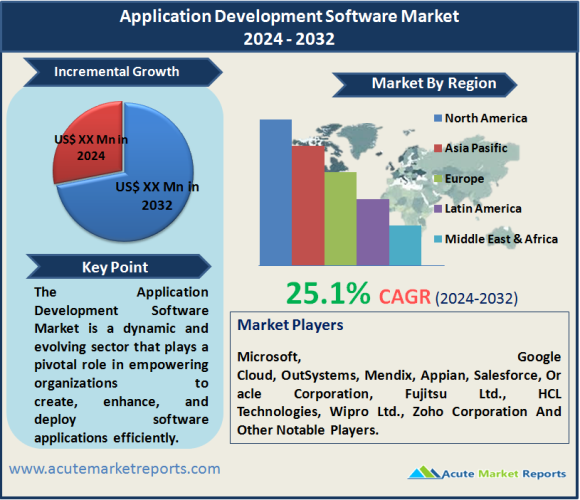
The application development software market is a dynamic and evolving sector that plays a pivotal role in empowering organizations to create, enhance, and deploy software applications efficiently. The application development software market is expected to grow at a CAGR of 25.1% during the forecast period of 2025 to 2033, driven by rapid technological advancements, the increasing popularity of low-code platforms, and global digital transformation initiatives. Despite cybersecurity challenges, the industry is adapting to meet the evolving needs of diverse sectors. The dominance of North America is expected to persist, but the Asia-Pacific region presents substantial opportunities for market expansion. As key players continue to innovate and collaborate, the application development software market is positioned to play a crucial role in shaping the digital landscape across industries in the coming years.
Rapid Technological Advancements
The relentless pace of technological advancements has been a primary driver fueling the application development software market. In 2024, the industry witnessed breakthroughs in cloud computing, artificial intelligence, and machine learning. Companies such as Microsoft, with its Azure platform, and Google Cloud demonstrated the integration of cutting-edge technologies into their development tools. These advancements not only streamlined the application development process but also enabled the creation of more sophisticated and feature-rich software applications.

Increasing Demand for Low-code Development Platforms
The rise in demand for rapid application development led to the prominence of low-code development platforms in 2024. Vendors like OutSystems, Mendix, and Appian witnessed substantial growth as organizations sought solutions that empower users with varying levels of technical expertise to participate in the development process. The evidence lies in the increasing adoption by enterprises across diverse industries, as low-code platforms became instrumental in accelerating application development cycles and minimizing the reliance on traditional coding.
Global Digital Transformation Initiatives
The worldwide push towards digital transformation initiatives has been a driving force behind the surge in demand for application development software. Companies, particularly in the BFSI sector, such as Salesforce with its Lightning Platform, capitalized on the need for agile and scalable application development to support digital transformation goals. The evidence lies in the robust growth of these platforms, with organizations leveraging them to create customer-centric applications and enhance overall operational efficiency.
Restraint
Despite the positive momentum, a significant restraint in the application development software market is the challenge of ensuring cybersecurity in application development. In 2024, instances of data breaches and cyber-attacks on applications highlighted vulnerabilities in the development process. Companies like Equifax and Facebook faced security breaches, underscoring the need for robust security measures during the application development lifecycle to protect sensitive data and maintain user trust.
Market Segmentation by Type - Low-code Development Platforms Dominate the Market
The market can be segmented based on the type of development platforms, including low-code and no-code platforms. In 2024, the highest revenue was generated by low-code development platforms, reflecting the industry's preference for solutions that strike a balance between customization and ease of use. However, during the forecast period of 2025 to 2033, the highest Compound Annual Growth Rate (CAGR) is expected in the no-code development platforms segment, indicating an increased focus on empowering non-developers to participate in the application development process.
Market Segmentation by Application – BFSI Segment Dominates the Market
Segmenting the market by application includes diverse sectors such as BFSI, media & entertainment, IT & telecom, healthcare, travel & tourism, and others. In 2024, the highest revenue and CAGR were observed in the BFSI sector, driven by the need for secure and agile financial applications. However, during the forecast period of 2025 to 2033, the highest CAGR is anticipated in the healthcare sector, signaling increased digitalization and application development initiatives within the healthcare industry.
North America remains the Global Leader
Geographically, the application development software market exhibited varied trends. In 2024, North America led in both revenue and CAGR, driven by a robust technology landscape and high adoption rates. However, the Asia-Pacific region is expected to experience the highest CAGR during the forecast period, reflecting a growing emphasis on digital transformation and application development initiatives in emerging markets.
Market Competition to Intensify during the Forecast Period
Top players in the application development software market include Microsoft, Google Cloud, OutSystems, Mendix, Appian, Salesforce, Oracle Corporation, Fujitsu Ltd., HCL Technologies, Wipro Ltd., Zoho Corporation, and others. These companies deploy diverse strategies, such as partnerships, acquisitions, and continuous innovation, to stay competitive. In 2024, their revenues reflected market leadership, with expectations of sustained growth during the forecast period.
Historical & Forecast Period
This study report represents analysis of each segment from 2023 to 2033 considering 2024 as the base year. Compounded Annual Growth Rate (CAGR) for each of the respective segments estimated for the forecast period of 2025 to 2033.
The current report comprises of quantitative market estimations for each micro market for every geographical region and qualitative market analysis such as micro and macro environment analysis, market trends, competitive intelligence, segment analysis, porters five force model, top winning strategies, top investment markets, emerging trends and technological analysis, case studies, strategic conclusions and recommendations and other key market insights.
Research Methodology
The complete research study was conducted in three phases, namely: secondary research, primary research, and expert panel review. key data point that enables the estimation of Application Development Software market are as follows:
Market forecast was performed through proprietary software that analyzes various qualitative and quantitative factors. Growth rate and CAGR were estimated through intensive secondary and primary research. Data triangulation across various data points provides accuracy across various analyzed market segments in the report. Application of both top down and bottom-up approach for validation of market estimation assures logical, methodical and mathematical consistency of the quantitative data.
| ATTRIBUTE | DETAILS |
|---|---|
| Research Period | 2023-2033 |
| Base Year | 2024 |
| Forecast Period | 2025-2033 |
| Historical Year | 2023 |
| Unit | USD Million |
| Segmentation | |
Type
| |
Deployment Type
| |
Organization Size
| |
Application
| |
|
Region Segment (2023-2033; US$ Million)
|
Key questions answered in this report